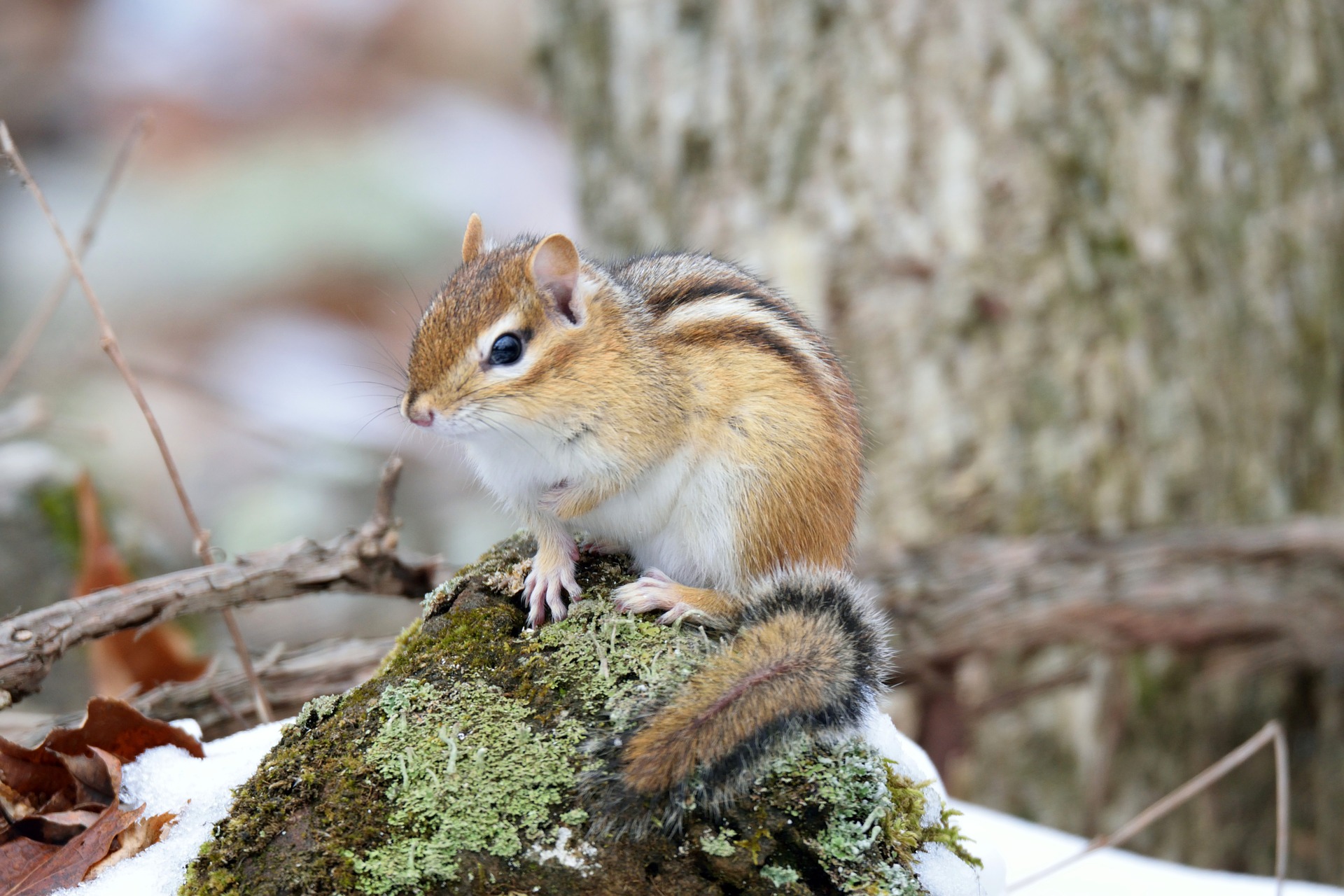Chipmunk Control
Chipmunk Removal Services, When You Need It!
Humane Chipmunk Trapping & Exclusion
Chipmunks can be a pest because of their burrowing activities, which can cause damage. Decks, patios, foundational walls, retention walls, and slabs are all susceptible to structural damage. Chipmunks also bring fleas and other insects into your yard. Since pesticides and poisons are proven to be ineffective against these critters, your best option is to contact Best Way Animal Removal for professional chipmunk removal services in Holland, Michigan.
Identification Of Chipmunks

In North America, there are fifteen species of native chipmunks belonging to the genus Eutamias and one species belonging to the genus Tamias. The two most widely distributed and notable species are the eastern chipmunk (Tamias striatus) and the least chipmunk (Eutamias minimas). All native chipmunk species have similar behavior and damage, so damage control recommendations are the same for all species.
Eastern Chipmunk
The eastern chipmunk is a small ground-dwelling rodent that is brownish in color. It’s usually 5 to 6 inches long and weighs around 3 ounces. On its back, it has two tan and five black lines that are stretched out horizontally. On each side of its face, it has two tan and two brownish horizontal lines. The reddish rump is where the longitudinal stripes end. The hairy tail is 3 to 4 inches long and not bushy.
Least Chipmunk
The tiniest of the chipmunks is the least chipmunk. It ranges in length from 3 2/3 to 4 1/2 inches and weighs 1 to 2 ounces. The color ranges from a pale yellowish gray with dark tawny stripes to a grayish tawny brown with black lines. On all least chipmunks, the stripes continue to the base of the tail.
Habitat Of Chipmunks

Chipmunks in the eastern United States live in burrows that they dig themselves. This animal’s typical burrow is made up of numerous entrances and tunnels that are connected to one another. In a large chamber, they build their nests out of crushed or chewed leaves. Food is stored in other sections. There have also been reported cases of individuals nesting in hollow trees.
In Michigan, chipmunks live in both forested and urban areas. These rodents prefer a shelter home near a constant food source. Attics, sheds, and underneath home foundations are common nesting spots because they provide ample security and are near food sources (trash cans, gardens, etc)
Signs Of Chipmunks In The Home
Chipmunks can be pretty destructive despite their diminutive size, particularly when burrowing near a home’s foundation. Signs of chipmunks on your property include:
- Bulbs that have been uprooted.
- Foundation or structural damage caused by chipmunk burrows.
- Underneath bird feeders, piles of seeds.
- Chipmunk tracks are small prints with four front toes and five back toes (front and hind feet are generally reversed).
- Digging for plant roots leaves holes in the lawn or garden.
How Can Chipmunks Enter The Home?
Burrowing animals, chipmunks prefer to live underground. With several food storage chambers, a nesting chamber, and escape tunnels, a chipmunk burrow can be quite elaborate. As a result, they will typically enter a home through ground-level entry points, such as a rotted sill, just above the foundation wall, or beneath a deck, stairs, or patio. They could also use a broken window or another easy access point.
If your house has a crawl space beneath it, a chipmunk might dig a burrow there to utilize the slightly warmer ground. Chipmunks, on the other hand, can survive quite well in natural burrows.
Chipmunks don’t usually seek shelter in people’s homes. It’s also unlikely that the sounds you hear in your attic are coming from chipmunks. Squirrels are more likely to be the culprits.
Chipmunk Damage In The Home

They are not large, but when the infestation grows in size and begin digging holes, you will be surprised to learn that your home’s foundation may be in jeopardy. Their holes start inside the house and continue until they gain access to your home. Fences may also be undermined because most animals continue to enter through holes dug under the fences. If it’s just one chipmunk, it won’t do much damage, but if there are many of them, like 50 or more, you can expect a lot of damage.
They enjoy the garden because they know there are many fruits and flowers to be found there. Insects fly freely in the garden, which they can catch and eat. They dig holes, stay inside, and come out at night to hunt and get food for themselves once they realize the garden is the perfect place for them. The roots of the majority of the crops will be destroyed, and your garden plants will begin to perish. They even designate routes within the garden that they will follow each time they go hunting.
Diseases Carried By Chipmunks
The plague, salmonella, and hantavirus are the most common diseases spread by chipmunks. Plague is an immune-system-attacking bacterial infection. It is usually spread through the bites of infected rodents’ fleas. Chipmunks spread salmonella in the same way the plague spreads it. This disease is characterized by severe gastrointestinal distress as well as joint pain. Finally, the lungs are affected by the hantavirus. People become infected with the hantavirus after coming into close contact with rodent urine or feces. All three illnesses can be fatal if left untreated.
Chipmunk Control & Prevention
Trapping is the most effective and recommended method of chipmunk control. We set live traps near holes and feeding areas that catch the chipmunks and keep them safe until they can be relocated to a designated wildlife area. To ensure that live chipmunks do not return, they must be relocated at least 10 miles away from the customer’s home or business. Chipmunks can be controlled with patience and persistence, as well as a combination of repellents and trapping.
Chipmunk Removal Process
Step 1: A thorough initial inspection is the foundation of any high-quality service. Our technicians will search for entry points and any environmental or construction issues that could allow access or contribute to your current or future chipmunk issues.
Step 2: Our technicians will assess all reasonable solutions and review the approach we’re recommending to resolve the issue after our initial inspection. Our technicians will go over our service scope with you and answer any questions you may have about chipmunk removal and the exclusion services we can or cannot provide.
Step 3: The most effective way to get rid of chipmunks on your property is to use live trapping. Chipmunks are caught in live traps, which are designed to capture them without harming them. These traps work by using a propped-open trap door or gate. The animal steps on the trigger plate, which is located between a non-poisonous bait and the trap door or gate, tripping the door or gate.
Step 4: Follow-up services are planned to inspect the traps for any wildlife caught and to rebait, reposition, or add additional traps as needed. For our live trapping services, we usually perform five services in total. To reduce the amount of time the animal spends in the trap, service visits are spaced 24 hours apart.
Step 5: After trapping services have been completed, we may install materials to exclude entry points. However, we always conduct an initial on-site inspection to determine whether we can or cannot provide this service at your location. We may not be able to close off entry points in some cases because it would be more appropriate for a licensed contractor to do so.
Get The Chipmunk Removed Today
Contacting animal removal professionals is the best way to ensure that your chipmunk infestation is handled safely and legally. Our Wildlife control technicians are trained in chipmunk exclusion and removal. They can not only get rid of chipmunk infestations, but they can also give you tips on how to avoid future chipmunk activity. Set your worries aside and allow Best Way Animal Removal to rid your home of chipmunks.
Areas Serviced For Chipmunk Control & Prevention
Allegan County, MI
Allegan, Douglas, Fennville, Holland, Hopkins, Martin, Otsego, Plainwell, Saugatuck, South Haven, Wayland
Kent County, MI
Byron Center, Caledonia, Casnovia, Cedar Springs, Comstock Park, Cutlerville, East Grand Rapids, Forest Hills, Grand Rapids, Grandville, Kent City, Kentwood, Lowell, Northview, Rockford, Sand Lake, Sparta, Walker, Wyoming
Muskegon County, MI
Casnovia, Fruitport, Lakewood Club, Montague, Muskegon, Muskegon Heights, North Muskegon, Norton Shores, Ravenna, Roosevelt Park, Twin Lake, Whitehall, Wolf Lake
Ottawa County, MI
Allendale, Beechwood, Coopersville, Ferrysburg, Grand Haven, Holland, Hudsonville, Jenison, Spring Lake, Zeeland
